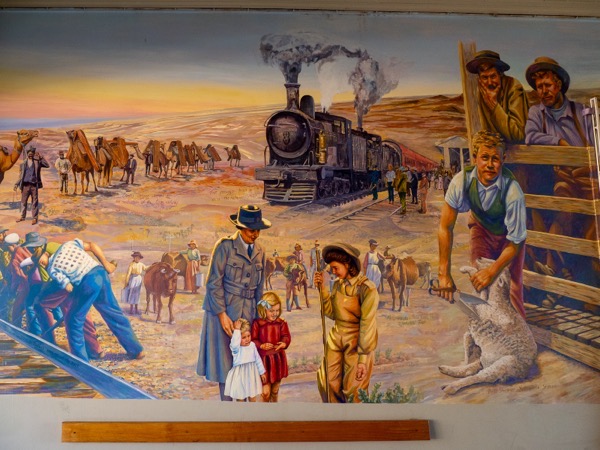
Tonight, we are back in the big smoke, or at least as big as is Port Augusta at the head of the Spencer Gulf. It’s large enough to have at least two supermarkets and a car wash – the largest town we have seen in five days.
Last night, our final one in the Flinders Ranges, we were treated to a spectacular display of stars. There was no light to create any pollution that interfered with the night sky and I was able to get my camera on a tripod and take some good photos of the Milky Way above us.

We only had a trip of 140 kilometres today so we could afford to take our time. I contacted our insurance company about the loss of my drone and providing that I can find the receipt for it when I get home, they will replace it with a new one (minus a $500 deductible payment). It was also my birthday today and I am grateful for all the greetings that people sent me by phone, text, email and on Facebook.
Between Hawker and the little town of Quorn, we passed a number of historic sites where farming communities had been established in the late 1800s after the railway line was built. All that is left of them now are a few ruins. We stopped at one location named Wilson (no connection to us). The most significant ruin there was the old Station Master’s Residence and an old water tank. I don’t quite know what the Station Master did with all of his time as only one train per week came through this station. In those days, he would have been an important person and every station had to have one.

Up the hill a little way was a small cemetery with some lonely graves. Most of the deaths appeared to be in the late 1890s. One family, coincidentally named Wilson, lost four children – none living longer than eight weeks. Life was extremely tough for these pioneers.
My knowledge of history is that this was the time of a very severe drought – The Federation Drought, so named because it was the time when the separate state colonies were holding discussions about joining together to form the Commonwealth of Australia. The late 1880s and early 1890s was a period of good rainfall over eastern Australia and this encouraged people to settle in areas that would otherwise not support agriculture. As well, the railway was opening up new areas. The Federation Drought began in 1895 and reached its peak in 1901 and 1902. Economic depression and labour strikes such as the national shearers strike added to the effect of the drought. At that time, wool accounted for most of Australia’s economy and as a result of the drought, sheep and cattle numbers fell from 91 to 54 million, and 11.8 to 7 million respectively. This resulted in one of the most severe recessions in Australia’s history.

The road continued through undulating hills until we reached Quorn. This area is still quite arid.

Quorn currently has a population of around 1300 people. It was important because of its place in the railway network. In 1917, Quorn became the crossroads of any north–south (on the Central Australian Railway to Oodnadatta, and later to Alice Springs) or east–west travel in Australia, when the Trans-Australian Railway was completed between Port Augusta and Kalgoorlie. This made Quorn an important town, given that any person travelling east–west or north–south in Australia would need to pass through here. As a result, many fine buildings were built as the town expanded.

My Dad would have passed here before continuing on to Hawker and then along the old Ghan railway to the Northern Territory. He spent the first part of WW2 at a number of supply depots that were staging points in keeping the war effort in Darwin supplied. Later, he was posted to forward supply depots in Malaysia and Borneo.

From Quorn we followed the old Ghan railway line south to Port Augusta. The enthusiast run Afghan Express now provides a return trip between the two towns (78 kilometres return). The train usually consists of Ghan carriages from the 1920s and is often hauled by an original Ghan steam locomotive and it recreates the type of travel experienced on the Ghan in the 1930s and 1940s. We assume that this stop at Woolshed Flats would have been part of this experience.

We were in Port Augusta for lunch and spent the afternoon catching up on some personal maintenance tasks. We needed to rationalise some of the supplies that we were carrying for breakfasts and lunches so a visit to the supermarket was necessary. We ate lunch at the old wharf area of the Port. Mabny people have told us that this town is desolate without much to offer. Our experience, perhaps after a week in remote areas, is that this is not quite the case.

I also needed some time to thank people people for their birthday greetings, buy some fuel and take our car to the car wash to remove most of the red dust from outback roads and some mud from when we drove through roadworks in the Parachilna Gorge.
We found a couple of nice murals at the Port Augusta Station that illustrated how the railway was developed and its role in opening up much of the remote regions of the state.

Tonight, we re dining at the Western Hotel – the best place that I could find to celebrate my birthday.



some lovely photos and interesting info. great stuff